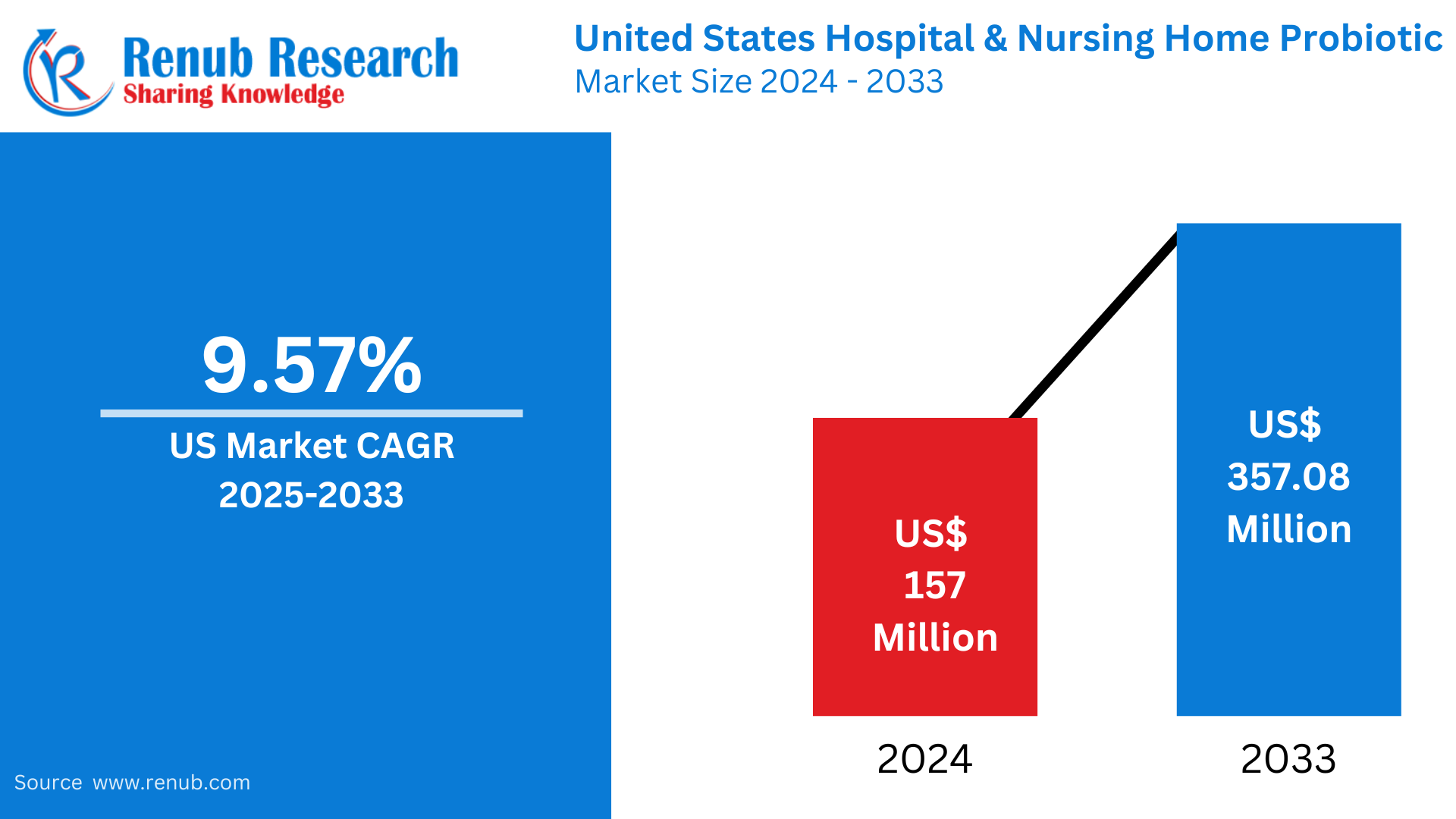United States Hospital & Nursing Home Probiotics Market: Detailed Analysis and Forecast (2025-2033)
Executive Summary
The United States Hospital & Nursing Home Probiotics Market was valued at approximately US$ 157 million in 2024 and is projected to grow significantly, reaching US$ 357.08 million by 2033. This represents a Compound Annual Growth Rate (CAGR) of 9.57% from 2025 to 2033. Probiotics, which are live beneficial bacteria, are increasingly used in healthcare facilities like hospitals and nursing homes due to their role in enhancing gut health, boosting immunity, and preventing infections. This market is driven by the aging population, rising awareness of the benefits of probiotics, and the growing need for infection control.
Market Overview
What Are Probiotics and Their Role in Healthcare?
Probiotics are live microorganisms that provide health benefits when consumed in adequate amounts. In healthcare settings, particularly hospitals and nursing homes, they are used to restore gut microbiota balance, prevent infections, manage gastrointestinal disorders, and enhance immune functions. Probiotics are commonly administered through supplements, fortified foods, and beverages.
Importance of Probiotics in Healthcare
- Gut Health: Probiotics promote a balanced gut microbiome, preventing conditions such as Clostridium difficile infections, antibiotic-associated diarrhea, and gastrointestinal disorders.
- Immunity Enhancement: Probiotics help in strengthening the immune system, which is vital in hospitals where patients are vulnerable to infections, especially post-surgery or during cancer treatments.
- Overall Health: Probiotics aid in improving nutrient absorption, especially for elderly patients with compromised digestive systems.
Drivers of Market Growth
1. Increased Healthcare Awareness of Gut Health
The understanding of gut health’s significance on overall wellbeing has risen dramatically in healthcare facilities. The inclusion of probiotics in treatment protocols, especially for elderly patients in nursing homes, has grown as more clinical studies validate their health benefits. This is particularly important as the number of Americans suffering from digestive issues increases.
2. Aging Population and Rise in Chronic Diseases
The aging U.S. population is more susceptible to gastrointestinal issues and reduced immunity. Probiotics are being used to address these concerns, especially in the elderly who often suffer from chronic diseases like diabetes and cardiovascular conditions. According to estimates, the number of Americans aged 65 and older will rise from 58 million in 2022 to 82 million by 2050, contributing significantly to market demand.
3. Growing Use of Antibiotics and the Need for Microbiome Restoration
With the increased use of antibiotics in hospitals, there is a growing need for probiotics to restore gut flora and prevent antibiotic-associated issues. In 2022, approximately 236.4 million antibiotic prescriptions were filled in the U.S., driving demand for probiotics in healthcare facilities to maintain gut health and prevent secondary infections.
Challenges Impacting Market Growth
1. Regulatory Uncertainty and Lack of Standardization
Probiotics are categorized as dietary supplements by the FDA, not as pharmaceuticals. This creates issues with product standardization, quality control, and efficacy claims, making it difficult for healthcare providers to incorporate probiotics safely into patient care protocols.
2. High Costs and Limited Insurance Coverage
The cost of probiotic supplements and fortified foods can be high, limiting their widespread adoption in healthcare settings. Additionally, insurance providers, including Medicare and Medicaid, often do not cover probiotics, which limits their use, particularly for elderly patients in long-term care.
Market Segmentation
1. By Hospital Type
Hospitals are segmented by the number of beds, payer type (e.g., Medicare, Medicaid), and location (urban vs. rural). Larger hospitals with more than 500 beds are more likely to implement probiotics due to the higher volume of patients and specialized units like gastroenterology.
2. By Nursing Home Type
Nursing homes are categorized by the number of beds and payer type (Medicare, Medicaid, Dual). The demand for probiotics is higher in nursing homes with over 200 beds, where residents typically have more significant health issues that require probiotics for digestive and immune support.
New Publish Reports
- United States Olive Oil Market Size and Share Analysis – Growth Trends and Forecast Report 2025-2033
- United States School Furniture Market Size and Share Analysis – Growth Trends and Forecast Report 2025-2033
- United States Biscuits Market Size and Share Analysis – Growth Trends and Forecast Report 2025-2033
- United States Communication Equipment Market Size and Share Analysis – Growth Trends and Forecast Report 2025-2033
Regional Analysis
1. Northern United States
The northern U.S. states, including New York, Massachusetts, and Illinois, are major players in the probiotics market. These states have large healthcare facilities, and the high population of elderly individuals in these regions contributes to the rising demand for probiotics.
2. Southern United States
In southern states like Florida and Texas, the increasing number of retirement communities and elderly individuals drives the adoption of probiotics, particularly in nursing homes. The warm climate and growing awareness of gut health further fuel the demand for probiotics.
3. Rural Areas
While rural nursing homes face challenges like fewer healthcare specialists and limited financial resources, the use of probiotics is increasing as access to products improves through telemedicine and online markets.
Competitive Landscape
The market is fragmented with key players such as American Lifeline Inc., Rising Pharmaceuticals, BD, Probi, and Lallemand Inc. leading the way in providing probiotics in healthcare facilities. These companies are focusing on innovations in probiotic formulations and expanding their product offerings to cater to the growing demand in U.S. hospitals and nursing homes.
Key Questions Answered in the Report
- What is the current market size of the U.S. Hospital & Nursing Home Probiotics Market?
- What is the projected growth rate (CAGR) of the market from 2025 to 2033?
- How are probiotics contributing to the management of antibiotic-associated diarrhea and gastrointestinal disorders?
- What are the challenges faced by healthcare providers in adopting probiotics in hospitals and nursing homes?
- Which geographic regions in the U.S. are seeing the highest growth in probiotic adoption in healthcare settings?
Conclusion
The U.S. Hospital & Nursing Home Probiotics Market is poised for significant growth, driven by increased healthcare awareness, a rising elderly population, and the need for effective infection control and gut health management. However, challenges such as regulatory issues and high costs need to be addressed to unlock the full potential of probiotics in healthcare facilities.
For detailed insights and to stay ahead of market trends, Renub Research offers tailored reports and analysis, ensuring you make informed decisions to thrive in this growing sector.

